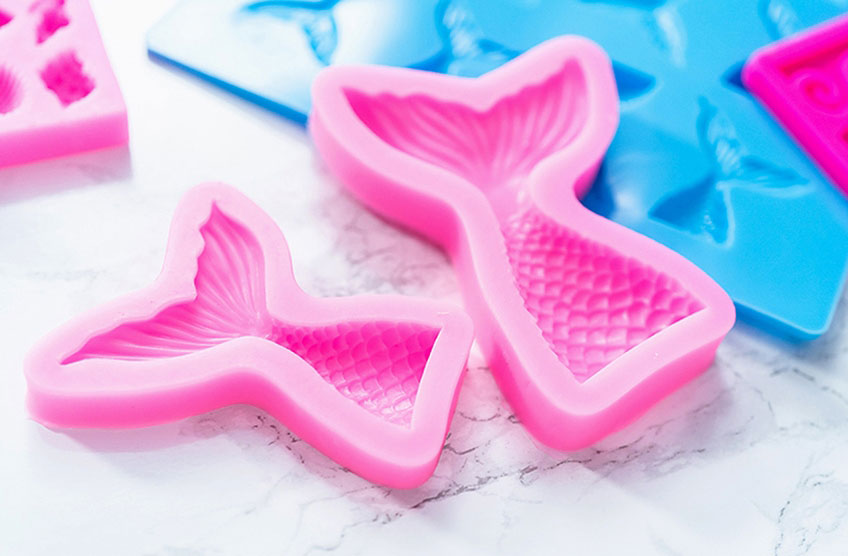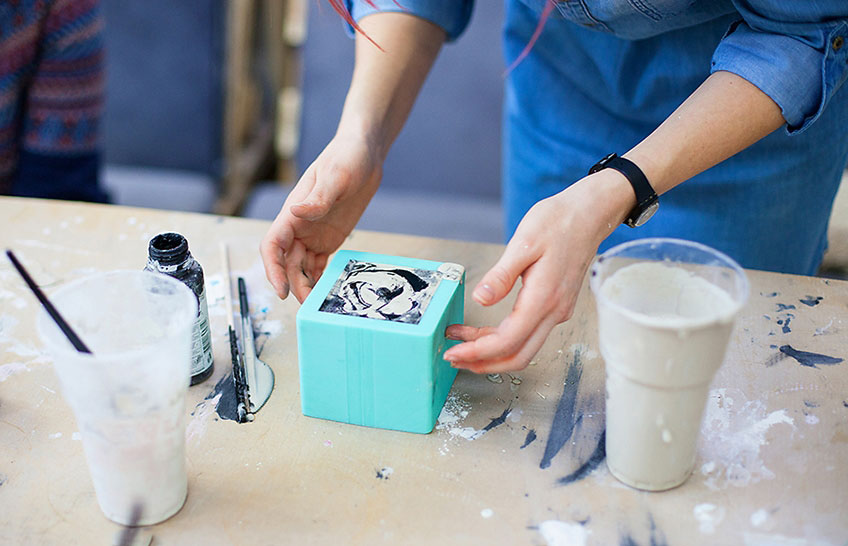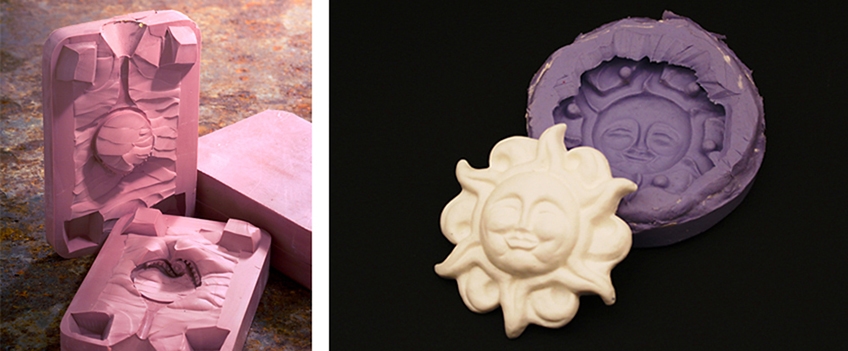Synthetic materials have become such an integral part of our lives that most of us rarely think about them. Although initially, they had a decidedly bad impact on the environment, we have since adopted more eco-friendly production methods improving their sustainability and toxicity levels. Silicone is one of many such materials, and its uses are virtually limitless in both commercial and regular crafting practices. Silicone can be used as an adhesive, insulator, sealant, and even to create molds for resin casting! Let’s have a look at the latter and how you can use silicone resin to create your own resin molds.
What Is Silicone Rubber and What Can You Do with It?
This is sort of a big question. It’s a bit like asking what people do with water – there are simply too many variations of its use to run through. Although, hypothetically, if someone who has never seen water before asked you this question, you would likely be able to give them a decent idea, and that’s what we’ll be aiming for here. Silicone was discovered by a gentleman named Jöns Jackob Berzelius back in 1824 when he was messing around with chlorine solutions, and since its discovery, we have found a wide range of uses for the material in all facets of life. Because silicone is flexible, durable, somewhat heat-resistant, is airtight, does not damage surfaces it comes into contact with, and can even be hardened for use with electronics. It has been used, for lack of a better phrase, quite excessively.
You can find silicone in your home’s kitchen. Baking trays, cake molds, egg flippers, knife sheaths, turkey basters, food containers, and strainers are all made of silicone rubber. In the automotive and electronics field silicone rubber can be used to create gasket sets, insulation for exposed wiring, seals for oil containers, trim for vehicle exteriors, grips for screwdrivers, and containers for tools.
Silicone rubber can even be found in the clothing industry, many brands use silicone rubber to create 3D prints on t-shirts, aftermarket soles for shoes, pull strings and retainers, hair ties, bracelets, and even hairbrushes.
One of the latest applications silicone rubbers has found a foothold in is the creation of (in both large and small scale) resin molds. These resin molds allow one to create an intricate and often stunning form that can be used for decorative or practical applications. These products are often sold in what has come to be known as a silicone mold kit, these kits provide the materials and instructions necessary to create a negative form of an object which you can then use to replicate said object in the form of a resin casting.This is such an effective way of affordable replication that one might consider it over 3D printing in some instances, even though the latter is far more accurate in regard to the dimensions of the object being replicated. We have also a separate tutorial on how to make silicone molds for resin.
![]()
What Is the Best Silicone Mold Kit?
Silicone mold is a pretty straightforward material as far as crafting supplies go, so why does every silicone mold kit claim to be the best one on the market? Let’s have a look at some of the best products on the market today and see why they claim to be the best silicone mold kit out there while comparing some of their pros and cons.
Best Overall: ALUMILITE Amazing Mold Maker
Our top pick for the best silicone mold kit is the one from Alumilite! What makes this arguably the best silicone mold kit on the market today? Well, not only is this mold’s material highly resistant to heat, tearing, abrasion, morphing, and dishwasher safe, but it is also platinum-based to further reinforce quality and longevity for virtually countless uses in the future. This is the best silicone mold kit to have when your project is time-sensitive and you need your mold to be sturdy, but don’t have hours to wait for the material to set before the resin is poured in.
Alumlite’s formula cures into the negative form you have selected inside the 30-minute mark and is ready for use immediately after this. This mold is also extremely versatile and can be used with a number of other substances aside from casting resin due to its robust make-up. Alumilite’s formula is not only fast curing and easy to use, but it is also FDA approved which means it is safe to use with food products without any risk of toxicity of the contents.
This is great if you aim to make some interesting food containers or fun jelly holders for kid’s parties. According to the Alumilite team, this silicone mold resin is also graded for use with things like plaster, concrete, chocolate, soaps, and even candle wax! The Alumilite team does recommend letting the substance cure for 24 hours if you will be using denser (heavier) substances inside the mold to avoid the product breaking or warping.
Not only is mold reasonably priced for its durability and versatility but its two-part formula is easy to use and the molds are easy to clean! Simply pop them in your dishwasher or wash them by hand in some soapy water and you’ll be good to go. This is arguably the best silicone mold kit on the market, with two others coming in at a close second.
Best Finish: LET’S RESIN Silicone Mold Making Kit
Let’s Resin is a name that is well known by both new and more experienced crafters around the world, ensuring great quality resin and resin mold products throughout their range. Like the Alumilite brand we mentioned previously, the Let’s Resin team has opted for a formula with a platinum backbone to ensure the quality of the molds produced is strong, flexible, and won’t break after three or four uses. This product does have one thing over the Alumilite team though. Even though both products are virtually odorless and nontoxic the Let’s Resin mold-making kit is clear which means that you can add things like dyes and smaller objects into it without having to consider how visible it will be through the tint.
Just like the Alumilite mold kit, this one is easy to use and simply requires the resin and hardener to be mixed in a 1:1 ratio, and what’s more, is that this product seems to pride itself on its bubble-free finish which is great if you don’t have a vacuum/pressure chamber on hand. Users have said that this product is not only sturdy and re-usable, but it is really easy to work with when de-molding due to the flexibility of the mold’s material, which is pretty kid-friendly if you take its non-toxic and food safe characteristics into account.
This product makes its run for the best silicone mold kit on the market today by being a recognizable brand that is easy to use, easy to clean, versatile, virtually unbreakable, and customizable! The only drawback we can think of is that it seems to only be available in one volume so you might want to pick up a few bottles of the stuff if you have a larger project in mind. If you have an intricate object you’d like to replicate or simply want to have some fun with your kids this product will not disappoint, and with a dry time of 5 minutes (and a full set time of 12 hours), you won’t have to wait very long to enjoy your new creations!
Best Value: BBDINO Silicone Mold Making Kit
One of the lesser-known brands on the resin mold market today is the BBDINO mold-making kit from the company of the same name. At first glance, one might brush this brand off as one that simply makes resin products as an afterthought with their leftovers, but upon closer inspection, you will see that the BBDINO team take great pride in their resin mold solutions, which is illustrated in the quality of their packaging and the quality of the materials used to create their resin molds. The containers used to bottle the resin and the hardener use foil wrapping to ensure greater shelf life and greatly decrease the shelf life of the product, which means that even after initially opening the containers your materials will be good for months to come!
This product is also easy to use and even easier to pour, featuring a low viscosity liquid that runs like melted butter until combined. Once mixed together the resin and hardener form a mold formula that is platinum backed to ensure a mold that is robust and flexible enough to be used over and over again without any breakage or warpage. The BBDINO formula is also quite versatile and can be used with substances like candle wax, concrete, soap, resin, and even food products.
BBINO has stated these molds are food safe and recommend using them to create molds for things like chocolates and baked goods and even ice cubes! This product would be ideal for keeping your kids occupied on those rainy days or simply making creative forms for your appetizers when you have a party coming up, this being said this mold offers great value for money with the only drawback being that it only comes in a dyed blue form which means it can be a challenge to see what your castings will look like once they have cured completely.
What Are the Hardness Grades for Silicone Molds?
As we all probably know, silicone can be really hard (like an O-ring) or it can be really soft (Like an inner sole for your shoes) or it could be somewhere in-between (like the covers for your earbuds). This type of variation in hardness is measured in Shore hardness which is simply a scale measurement not unlike PSI (pounds per square inch). Different silicone mold products will produce molds of varying hardness and depending on your needs or application, you will likely need different harness ratings based on the material you intend on using with your silicone molds. Your resin mold kit can produce a mold with a hardness somewhere on the shore scale between 0 to 90 Shore hardness ratings. How do you determine the level of hardness you need for a given material?
Well, it goes without saying that the denser a material is the heavier it will be and considering how the weight and density will be distributed throughout your mold. This will determine how hard your resin mold will need to be once the casting has cured and hardened in order to prevent the mold from breaking, tearing, or losing its shape retention.

To give you a good idea of what shore hardness you might want your resin mold kit to have, consider that a Shore hardness of 10 would be equivalent to a marshmallow, whereas a shore hardness of 90 would be equivalent to human bone, which has the tensile strength of steel at optimum health. Choosing a hardness that suits your application can be crucial in determining how your casting turns out, so be sure to check the packaging or product description online to determine the product’s final state before you buy.
How Much Heat Can Silicone Rubber Take?
This is an interesting question. You have probably seen silicone being used in a number of applications throughout your daily life, you might not even realize there are objects and machinery around you that use silicone for crucial aspects of the functionality including your laptop and/or smartphone! So, how much heat can silicone rubber take? The answer might surprise you. Silicone rubber molds can, at any degree of hardness, withstand temperatures of up to 302 degrees Fahrenheit for up to 10 000 hours without losing their shape or form.
This integrity can vary depending on how the heat is applied and the quality of the silicone rubber used, although the aforementioned is the general consensus among researchers. This is all due to silicone rubber being a poor heat conductor, meaning it is commonly used as a cheap and effective way to insulate things.
Resin mold kits typically use a really good quality silicone rubber material so your mold will likely be able to take quite a bit of heat should you choose to expose it to such forces, although you should be more concerned about the substance you are using for casting. Resin mold kits and the resin you will be used to cast your form will have different grades, and therefore both product limitations should be considered before subjecting them to extreme heat.
How to Use Your Resin to Make a Mold?
Now that you know how to choose which resin is right for you, it’s time for you to learn how to use it! Most resin products will include clear instructions on or inside their packaging, but just in case you aren’t sure what to do, here is the best way to use your resin mold material. Without any further ado let’s get into it!


